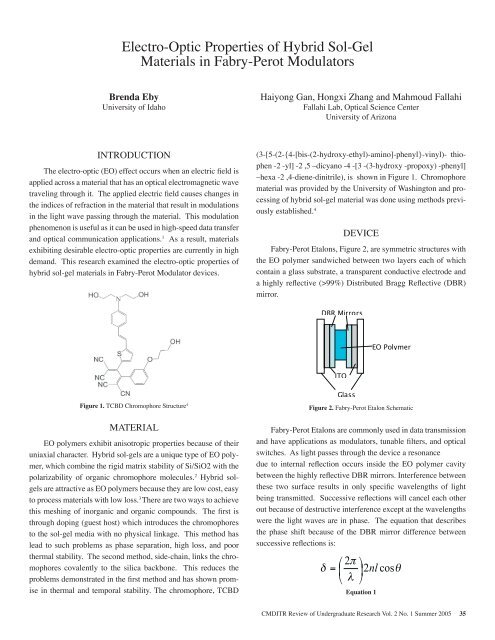Student Project Abstracts 2005 - Pluto - University of Washington
Student Project Abstracts 2005 - Pluto - University of Washington
Student Project Abstracts 2005 - Pluto - University of Washington
You also want an ePaper? Increase the reach of your titles
YUMPU automatically turns print PDFs into web optimized ePapers that Google loves.
(EO) effec tric field is high loss, and poor thermalial that has stability. Brenda The second Eby method,netic wave side-chain, <strong>University</strong> <strong>of</strong> links Idaho theThe applied chromophores covalently to thechanges in silica backbone. This reduces thetion in the problems demonstrated in theesult in first method and has shownlight wave promise INTRODUCTIONin thermal and temporalmaterial. stability. The chromophore, TCBDomenon is The electro-optic (3-[5-(2-{4-[bis-(2-hydroxy-(EO) effect occurs when an electric field ised in highandapplied across ethyl)-amino]-phenyl}-vinyl)-a material that has an optical electromagnetic waveoptical traveling through thiophen it. The -2 applied -yl] -2 electric ,5 –dicyano field causes -4 - changes intions. 1the As indices <strong>of</strong> [3 refraction -(3-hydroxy in the material -propoxy) that result -phenyl] in modulationsexhibiting –hexa -2 ,4-diene-dinitrile), isin the light wave passing through the material. This modulationproperties shown in Figure 1. Chromophorephenomenon is useful as it can be used in high-speed data transferh demand. material was provided by theined and the optical communication <strong>University</strong> <strong>of</strong> applications. <strong>Washington</strong> 1 As a result, and materialss <strong>of</strong> hybrid exhibiting desirable processing electro-optic <strong>of</strong> properties hybrid are sol-gel currently in highabry-Perot demand. This material research was examined done the using electro-optic methods properties <strong>of</strong>hybrid sol-gelpreviouslymaterials inestablished.Fabry-Perot Modulator devices.Electro-Optic Properties <strong>of</strong> Hybrid Sol-GelMaterials in Fabry-Perot Modulatorsmedia with no physical linkage.This method has lead to suchproblems as phase separation,exhibitbecause <strong>of</strong>r. Hybridtype <strong>of</strong> EOe the rigid/SiO2 withf organics. 2 Hybridve as EOy are lowmaterialse two waysFigure 1. TCBD Chromophore Structure 4eshing <strong>of</strong>compounds.MATERIALping (guestuces the EO polymers exhibit anisotropic properties because <strong>of</strong> theirhe sol-gel uniaxial character. Hybrid sol-gels are a unique type <strong>of</strong> EO polymer,which combine the rigid matrix stability <strong>of</strong> Si/SiO2 with thepolarizability CMDITR <strong>of</strong> Review organic <strong>of</strong> Undergraduate chromophore Research Vol. molecules. 1 No. 12 Hybrid solgelsare attractive as EO polymers because they are low cost, easyto process materials with low loss. 3 There are two ways to achievethis meshing <strong>of</strong> inorganic and organic compounds. The first isthrough doping (guest host) which introduces the chromophoresto the sol-gel media with no physical linkage. This method haslead to such problems as phase separation, high loss, and poorthermal stability. The second method, side-chain, links the chromophorescovalently to the silica backbone. This reduces theproblems demonstrated in the first method and has shown promisein thermal and temporal stability. The chromophore, TCBDHaiyong Gan, Hongxi Zhang and Mahmoud FallahiFallahi Lab, Optical Science Center <strong>University</strong> <strong>of</strong> ArizonaFabry-Perot Etalons, , aresymmetric structures with the EO polymer(3-[5-(2-{4-[bis-(2-hydroxy-ethyl)-amino]-phenyl}-vinyl)- sandwiched between two layers each <strong>of</strong> thiophen-2 -yl] -2 which ,5 –dicyano contain -4 -[3 -(3-hydroxy a glass -propoxy) substrate, -phenyl] a–hexa -2 ,4-diene-dinitrile), transparent is conductive shown in Figure electrode 1. Chromophore and amaterial was provided highly by reflective the <strong>University</strong> (>99%) <strong>of</strong> <strong>Washington</strong> Distributed and processing<strong>of</strong> hybrid Bragg sol-gel material Reflective was done (DBR) using methods mirror. previouslyestablished. 4Device<strong>of</strong>Whewavrefrais thgoinphasintertransare in phase. upondescribes theFabry-Perot Etalons, Figurethe DBR thick2, are symmetric structures with between tosucEthe EO polymerDEVICEsandwichedis: geneFabry-Perot between Etalons, two layers Figure 2, each are symmetric <strong>of</strong> which structures withcontain a glass substrate, apthe EO polymer sandwiched between two layers each <strong>of</strong> which d 2 the Ê ˆ=transparent conductive electrodeÁequa ˜¯2contain a glass substrate, a transparent conductive electrode and Ë land a highly reflective (>99%)a highly reflective (>99%) Distributed Bragg Reflective Where (DBR) is thDistributed Bragg Reflectivemirror. (DBR)incident wavemirror.<strong>of</strong> the film,DBR Mirrorsindex <strong>of</strong> the Ethe internal itranslight going tThe waves show inEO Polymer throughFabry-Perot Etalons are commonly usedinterference,data transmission and have applicationsnarrow as transmodulators,ITOtunable filters, and optical vary dependinswitches. As light passes through factors the showGlassThey includFigure device 1: Fabry-Perot a resonance Etalon SchematicFigure 2. Fabry-Perot Etalon Schematic change in refdue to internal reflection occurs inside theEO effect,EO polymer cavity between the highlyroughness.Fabry-Perot Fabry-Perot reflective Etalons are DBR commonly Etalons mirrors. used in are Interferencedata transmissiontransmissionand have commonly applications betweenas these modulators, used two surface in tunable data results filters, in and only theopticalphase sswitches. transmission As light specific passes wavelengths through and the device <strong>of</strong>havea resonance light being following equaapplications as modulators,due to internal transmitted. reflection occurs Successive inside the reflections EO polymer will cavitytunable filters, and opticalbetween the highly cancel reflective eachDBR other mirrors. out Interference becausebetween<strong>of</strong> dswitches. As light passesthese two through surface destructive results the device in interference only a resonance specific wavelengths except at <strong>of</strong> thelightwherebeing transmitted. due wavelengths to internal Successive were reflections the light occurs will waves cancel each are in other out because inside <strong>of</strong> phase. destructive the The EO interference equation polymer except that cavity describes A typicalat the wavelengths thewere the between light phase waves the are shift highly in because phase. reflective The <strong>of</strong> equation the DBR transmissionthat mirror describesmirrors. Interference betweenthis is shownthe phase shiftdifferencebecause <strong>of</strong>betweenthe DBRsuccessivemirror differencereflectionsbetweenthese is: two surface results in onlyWhesuccessivespecificreflectionswavelengthsis:<strong>of</strong> light beingshifttransmitted.Successiveandreflections will cancel each other indeout because <strong>of</strong> destructiveandinterference except at theEquation 1wavelengths were the light wavesFigure 1: TCBD Chromophore Structure 4 CMDITR Review <strong>of</strong> Undergraduate Research VoCMDITR Review <strong>of</strong> Undergraduate Research Vol. 2 No. 1 Summer <strong>2005</strong> 352 CMDITR Review <strong>of</strong> Undergraduate Research Vol. 1 No. 1 Summer 200




